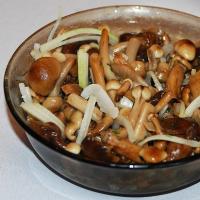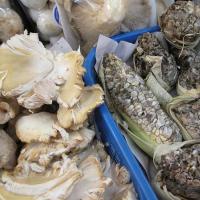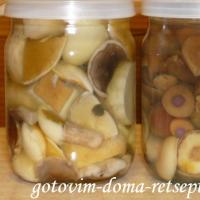Twin mushrooms: how to distinguish an edible species from a poisonous one?
Even when picking well-known mushrooms, there is a risk of putting a toxic specimen in the basket. After all, in addition to the usual red fly agaric or conditional grebes, in the forest you can find poisonous or simply inedible mushrooms, very similar to edible ones. In some cases, a mistake can cost a life, so you should carefully examine everything that you put in a basket. What to look for and where to expect a dirty trick? We have made a selection of common dangerous doubles
Summer mushrooms - bordered galerina - sulfur-yellow false honey agaric
Summer mushrooms.Summer honey agaric is probably not as popular as autumn, but it also has its admirers. And they should take note that this mushroom has a very dangerous double - a bordered gallery. What are the differences? Firstly, summer honey agaric bears fruit in large clusters. In turn, the galerina, even if it grows in groups, usually grows together no more than 2-3 mushrooms. Secondly, the leg: in the honey agaric, the lower part is scaly, in the twin, it is fibrous. In general, honey mushrooms are larger: their hat can reach up to 6 cm in diameter, in the gallery - more often up to 3 cm. If there is even the slightest doubt, it is better to refuse the find. Galerina fringed is deadly poisonous!
 The gallery is bordered.
The gallery is bordered.
 False foam is sulfur-yellow.
False foam is sulfur-yellow.
Another twin of the summer honey agaric is a sulfur-yellow false honey agaric. Unlike the edible one, this specimen does not have a ring. There are also differences in smell: an edible mushroom emits a pleasant mushroom aroma, while a false one has a more subdued smell. Sulphur-yellow false foam is not as poisonous as bordered galerina, but the consequences are also unpleasant: its use can cause abdominal cramps and mild poisoning.
Champignon - pale grebe (white)
 Champignon.
Champignon.  Death cap.
Death cap.
The key difference between champignon and poisonous twin is the color of the plates on the bottom of the cap. If in a pale grebe they are always white, then in an edible mushroom they are pink, and turn brown with age. At first glance, it is simple, but in practice it is not so easy to objectively determine the color, especially in a young mushroom: experience, lighting, and color perception are important here. The rule is the same: if in doubt, it is better to refuse to collect small, separately growing champignons. Eating a pale toadstool can cost your life!
Green russula - pale grebe (greenish gray)
 Green russula.
Green russula. Death cap.
Death cap.
To distinguish the russula from the pale grebe, you need to pay attention to the leg. Firstly, in a toxic fungus, it noticeably thickens downwards and has a well-defined volva - a membranous wrapper in the lower part of the stem, which is formed as a result of a rupture of the protective sac from which the mushroom grew. In young toadstools, this bag may still be intact - then there will be a tuber at the base. Secondly, the pale grebe has a ring at the top of the leg, which you will not find in the green russula.
Chanterelle real - chanterelle false
 The fox is real.
The fox is real. Fox is false.
Fox is false.
These mushrooms are similar only at first glance. There are several criteria. The double has a brighter color, the mushroom is bright orange or orange with a brown tint, and it is always lighter along the edge than in the center. True chanterelle color ranges from light yellow to yellow-orange, and the cap is evenly colored. The shape of the hat also matters. The false edges are even, neatly rounded, while the real edges are wavy, almost always irregular in shape. The plates of a real chanterelle are dense, thick, they go down the stem of the mushroom, becoming part of it. In the false one, they are thinner and more frequent, they also descend along the stem of the mushroom, but do not pass into it.
An error in this case is unlikely to lead to death: false chanterelles are not an edible mushroom, but do not cause serious poisoning. Still, you should not lose your vigilance.
White mushroom - gall fungus (gorchak)
 Porcini.
Porcini.  Bile mushroom.
Bile mushroom.
In principle, it is not difficult to distinguish the double of the king of the mushroom kingdom from a real white mushroom. First, pay attention to the leg. The gall fungus has a pattern in the form of a dense brown mesh on it. Some types of mushrooms also have it, but thinner and always white. Secondly, the pulp of the gall fungus darkens when cut, becoming pinkish-brown. This does not happen with white fungus. Thirdly, pay attention to the tubular layer: in a young mustard it is white, in an adult fungus it is pinkish or dirty pink, in a mushroom it is white, yellowish or greenish.
The gall fungus is inedible, although not poisonous. The reason for the inedibility is in the strong bitterness, which cannot be removed even with prolonged cooking. Therefore, one of its names is “gorchak”.
Tales for adults
It is unlikely that any question has generated as many myths as the definition of the toxicity of mushrooms.There are many popular “tests”! For example, supposedly worms and snails do not touch toxic mushrooms. Or - milk will curdle if you throw a poisonous mushroom into it. Another fiction: onions or garlic will turn brown when cooked, and silver will turn black if poison is wormed into the pan.
Leading Specialist of the Mycology Laboratory of the Institute of Experimental Botany named after V.F. Kuprevich of the National Academy of Sciences Olga Gapienko emphasizes: “Typical signs of poisonousness of mushrooms do not exist! Take even smell and taste. A classic example: the pale toadstool smells good and tastes sweet. Veselka smells bad, but it's not poisonous. So there are no methods, only the knowledge of mushrooms.”
Smartphone to the rescue
What apps are right for you
Mushrooms of BelarusThis program is, in fact, a handy automated reference. All mushrooms are divided into 6 categories: edible - well-known, little-known and conditionally edible, inedible - little-known and poisonous plus with unknown properties. For each mushroom - a photo and a detailed description. How can such a program help? For example, you found a mushroom - by all indications it seems to be white, but the color of the cap is unusual. Go to the application, and here there are 6 types of them. Choose the most suitable one from the photo and compare the information with what you see in front of you: do all the signs match? If nothing is in doubt, feel free to put the mushroom in a basket.
Ecoguide: mushrooms
The application consists of three parts: an encyclopedia atlas, a textbook and, most interestingly, a guide to mushrooms. Let's take a closer look at the last one. The program allows you to find out what kind of mushroom you are holding in your hands. To do this, you need to enter a number of external morphological features - the shape of the fruiting body, the parameters of the cap, legs, and so on, a total of 22 points. One of the obvious advantages of the application is that you can work with it without an Internet connection. Minus, however, justified - the program is paid. It costs $3.99 on Google Market.
I'm going home
The application has nothing to do directly with the search for mushrooms, but it will help you get out of the forest if you are carried away by a quiet hunt and you don’t know how to go back. To do this, you need to open the program at home, turn on GPS and wait until the application receives the coordinates of your location. Save this data, after which you can close the program and even turn off the phone. When you decide to return home from the forest, open the application and click the "Let's go home" button. With the help of voice prompts, the program will take you to the desired point. But keep in mind: it does not see the terrain and forms the shortest route without taking into account obstacles. So this option is better to use as a spare - in case you fail to catch a connection and use online navigators.



